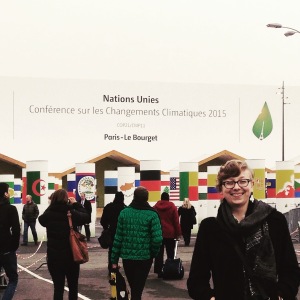After spending a week in Paris at the COP21 global climate talks, CFE staffer Sarah Ganong offers her final musings on the outcome, and the hope in the way forward
Whew. It’s done. We have a Paris Climate Agreement—32 pages of blood, sweat, and tears that have been in the works for 23 years. I spend the first week of the UN talks inside Le Bourget, tracking negotiations, reporting for folks back home, and advocating as a youth for a strong and equitable agreement. While it is certainly far from perfect, there’s more nice than naughty in the final agreement.
 Certainly the biggest achievement COP21 is the coalescing around 1.5 degrees C of warming as the global target. Although the final text of the agreement stipulates 2 degrees as the “official” target, it also says that we should collectively aim for 1.5. What began as a collection of Small Island States and other especially vulnerable parties turned into a “High Ambition Coalition” of major players, including the U.S. While 1.5 degrees of warming will still have dangerous consequences, it’s safer than 2 degrees, and is a target that most advocates didn’t think would make it into the Paris Agreement. Definitely one for the nice list!
Certainly the biggest achievement COP21 is the coalescing around 1.5 degrees C of warming as the global target. Although the final text of the agreement stipulates 2 degrees as the “official” target, it also says that we should collectively aim for 1.5. What began as a collection of Small Island States and other especially vulnerable parties turned into a “High Ambition Coalition” of major players, including the U.S. While 1.5 degrees of warming will still have dangerous consequences, it’s safer than 2 degrees, and is a target that most advocates didn’t think would make it into the Paris Agreement. Definitely one for the nice list!
Other important pieces of the agreement include progress on providing climate finance to the poorest and most vulnerable countries—those that have little historic responsibility for emissions of greenhouse gases, but that are already being hit the hardest by climate change. They’ll need money to adapt to climate change, but also deserve compensation for loss and damages—the inevitable destruction caused by climate change that we’re going to be unable to prevent, like sea level rise and severe storms. Countries will also be taking stock of and “ratcheting up” their emissions reduction pledges starting in 2018. When it comes to acting on climate, sooner is always better, so pushing hard for more ambitious targets over the next couple of years will be crucial.

But perhaps the most inspiring part of all of COP21 was the people that I met. From Switzerland to Norway, from India to Brazil, I made friends with inspiring activists who spend two weeks a year focusing on global treaties. But for the other 50 weeks a year, we’re all tackling other environmental issues at home. We’re taking on major new fossil fuel infrastructure projects—and winning. We’re working on the local and regional levels to push for strong emissions reduction targets.
President Obama called the Paris Agreement the “best chance we have” to save the planet. I disagree. While an international plan is crucial, the real best hope is the people around the world, working in their hometowns to save the places that they love. The international process has been happening nearly as long as I’ve been alive, and in that time we’ve seen global emissions rise by 60 percent. While it’s great that the world has finally come up with a truly global agreement, we can’t wait on our governments anymore. The true hope of the season lies with the people, and we’re ready.
In other climate news
In that vein, COP21 has already provided momentum to a variety of local and national initiatives, including an exciting announcement here in Connecticut. EPA head Gina McCarthy recently stopped by with a “postcard from Paris” for an announcement by 22 car dealers in Connecticut—many of whom have already done great work promoting climate-friendly electric vehicles—that they’ll be installing solar on the roofs of their car dealerships. Well done!
Congress has been both naughty and nice in recent weeks. In the recent budget, they proposed to end restrictions on oil exports in place since the 1970s. In the wake of the Paris Agreement, many are seeing this as a sign from Congress and the fossil fuel industry to continue the fossil fuel economy longer than the planet can handle it.
But the same budget deal, in a surprise move, also extended tax credits for wind and solar in the U.S. for another five years—a huge boon that will seriously benefit the industry and the planet. One of the biggest problems for the renewable industry in the U.S. is the uncertain future for credits and tax breaks that help them to compete with fossil fuels in an economy where dirty energy still receives billions of dollars in government handouts each year. Now, with this certain funding from Congress, their future is a little more secure. And by the time the new tax credits expire in five years, wind and solar are projected to be the cheapest forms of electricity in many states around the country.
That’s a nice Christmas present, indeed!
